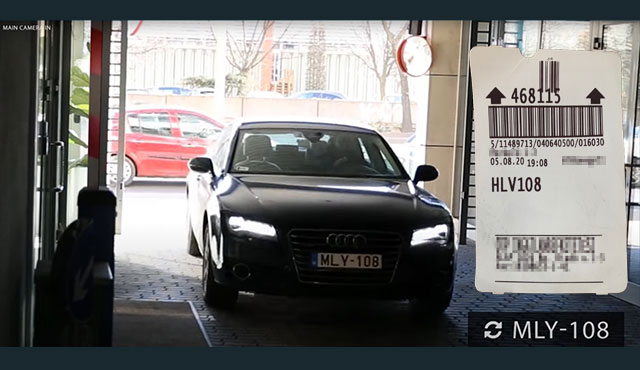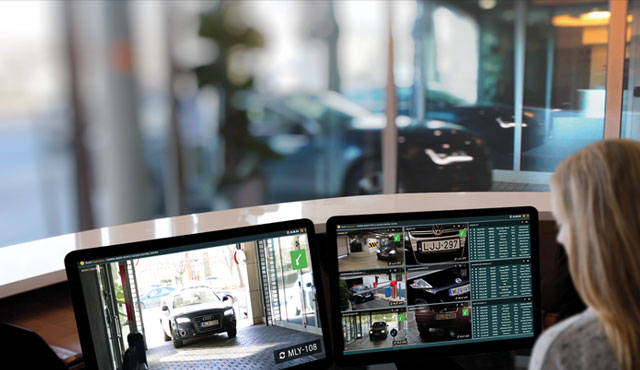We see and use more and more ANPR-assisted parking systems – where the technology of Automatic Number Plate Recognition is applied to identify incoming and exiting vehicles (an automated way of pay-by-plate parking). We all know the practical advantages of ANPR; how it makes parking automated, offers a smooth drive-in experience, and requires much less manual work. It’s a win for drivers and parking operators. So that is not a question…

But when technology is applied in the wrong way, it can do more harm than good. One day one of our managers parked in a Hungarian shopping mall. Although the parking system worked with ANPR (not ours), the software was inaccurate or the system was not properly calibrated. The consequence: the manager’s license plate was recognized as HLV-108 instead of the real MLY-108.
Problems of Inaccurate Recognition
Misrecognition not only disturbs the entry/exit management of a vehicle access control system but may imply future issues as well. For instance, what if the security staff wants to check if a vehicle has ever been in the area? What if they need its time of arrival? Or what if, for any reason, that specific vehicle should be on an unauthorized list, blocking it from future entry? Does the system fail to read the plate the same way every time – or does it recognize it as a different plate in each case?

So many questions and so many concerns… So, the best choice is to have a system with a high-accuracy ANPR component. Being in the development of such technology for 30+ years, we can certainly say, it is not an easy job. So let’s dive into the details and see how many factors contribute to a successful ANPR system!
Factors Affecting ANPR Accuracy Rates
No matter how good an image you get of a vehicle if the ANPR software is not accurate, making recognition errors or misreading characters. Also, you can have the very best ANPR engine, but if the image is too blurry or distorted, it will not result in proper license plate recognition.

One thing is sure: the ANPR performance starts at the imaging… and ends at the ANPR engine itself. Let’s see those factors that contribute to successful recognition.
- Input image quality: the image should show the vehicle and its license plate in a way that is readable to the human eye. The license plate should not be too small or too blurry, and the physical plate should not be too dirty or damaged. Fine-tuned ALPR software modules can still deal with part of these, but it’s best to filter out these issues in advance.
- Camera installation: the camera that captures the vehicle should be set in such a position that creates a distortion-free view of the plate. The less distortion the image has, the easier is the ANPR.
- Illumination: too dark images or photos with low contrast differences between the plate and its characters may make the ANPR software’s job difficult. That is why the proper license plate recognition cameras like Vidar have built-in infrared illumination – helping to image both in the daytime and nighttime.
- ANPR recognition engine: when evaluating an ANPR software product, it is not only about accuracy rate. Consider the speed of recognition, the geographical coverage, the flexibility in how the engine deals with special types, and more.
What to Pay Attention to?
So what went wrong in the example system? It is a complex question and may be a result of one or multiple of the factors above. Maybe the camera did not provide appropriate input for the software. Or the software simply did not have the best OCR algorithm. Maybe it was too dark and the system did not have the required illumination. Or maybe even further reasons.
When designing a parking system, you need to minimize the possibility of errors, from every aspect. Deal with the imaging, the illumination, the software – all the components that will define the outcome.
To set a good example, let us show you some of the projects we are proud of – ANPR systems around the world, like at the Vilnius Airport, in this Finnish automated car wash system, on the Colombian highways, or in these 5-star Dubai hotels.
Ways for Using ANPR in Your Parking System
Back to the original idea – ANPR can take your parking system to the next level if it works properly. It makes sense to use it, but how it is possible – you may wonder. Here, we explain some scenarios – ways to start using ANPR:
- Get a ready-to-use vehicle access control system with ANPR: if you are working on a new project, looking for a complete system, and do not wish to integrate components, select an end-user product. These systems usually include car access management software, the ANPR function, automatic barrier opening, user management, and more – ready for your usage.
- Add ANPR to an existing access control system: if your project already has an access control system but lacks the ANPR function, you can add it as an extra feature. You can do this in the following ways:
- Add ANPR software function: if there is already a camera that checks the entry/exit movements, you will need to integrate an ANPR function to extract the data from the images. You can find such SDKs and algorithms on the market – even free ones. You can also start using cloud-based ANPR SaaS (software-as-a-service) which may come in handy if you do not have the resources, budget, or time for integration and need an instant solution. (For that, let us draw your attention to our brand new ANPR cloud service; you can start a free trial up to 200 transactions here.)
- Add an integrated, smart camera: if you do not wish to connect the camera with software and fine-tune the image transfer, you can also get such ANPR-based traffic monitoring cameras that have onboard intelligence with a built-in ANPR function. This type of camera will provide ready-to-use results to your system.

If you like this article, check out our dedicated blog section for similar content.
All the mentioned products are available to purchase. If you have any questions, reach out to our experts:

